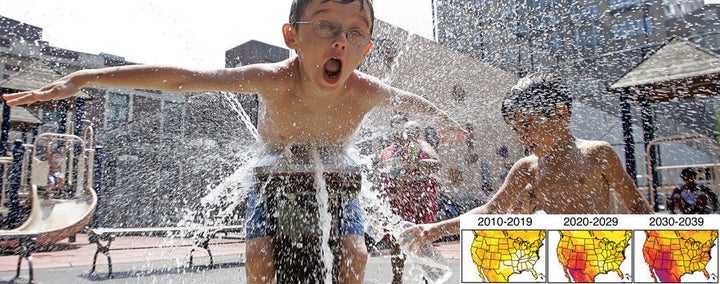
Devastating heat waves that result in fatalities and crop losses may increasingly become a common occurrence in the United States over the next three decades, according to a team of Stanford University researchers.
"Using a large suite of climate model experiments, we see a clear emergence of much more intense, hot conditions in the U.S. within the next three decades,: Noah Diffenbaugh, the lead author of the study, told the Stanford Report.
"In the next 30 years, we could see an increase in heat waves like the one now occurring in the eastern United States or the kind that swept across Europe in 2003 that caused tens of thousands of fatalities," said Diffenbaugh, a center fellow at Stanford's Woods Institute for the Environment. "Those kinds of severe heat events also put enormous stress on major crops like corn, soybean, cotton and wine grapes, causing a significant reduction in yields."

The group studied the hottest U.S. temperatures from 1950-1999, then fed them through multiple forecasting models that can simulate daily temperatures in the U.S. The forecasting models were based on the likely occurrence that carbon dioxide could raise temperatures 1.8 degrees Celsius.
Even if countries around the world meet the climate change goals put forward at the Copenhagen Climate Accord, and stop the world from warming by 2 degrees Celsius, smaller temperature increases could still contribute towards extreme weather.
To Diffenbaugh, the findings mean that to avoid severe heat waves, governments must look at the possibility that even a two degree increase is too much. "It's up to the policymakers to decide the most appropriate action," Diffenbaugh told The Stanford Report. "But our results suggest that limiting global warming to 2 degrees Celsius does not guarantee that there won't be damaging impacts from climate change."
In the past few days, a record heat wave in Russia has killed five people and prompted the government to call for siestas. During the month of June, high temperatures in the U.S. killed five seniors in Maryland, four people in Philadelphia, four people in Dallas, and three people in Tennessee.
On Sunday, train passengers in Germany had to vacate three trains after air conditioning broke down and temperatures reached 122 degrees Farenheit. Some were hospitalized.
Also this week, NASA data shows that global temperatures recorded from January through June 2010 were the highest ever.
Climate scientist Joe Romm notes:
It's all the more powerful evidence of human-caused warming "because it occurs when the recent minimum of solar irradiance is having its maximum cooling effect," as a recent NASA must-read paper notes. [...]
It still seems likely that 2010 will be the hottest year on record, but NOAA now predicts that "La Niña conditions are likely to develop during July - August 2010." If the La Niña comes fast and deep (as in 1998 and 2007), that could make it a close call in the NASA dataset -- and even more so in the satellite record, which is much more sensitive to ENSO ( El Niño Southern oscillation).
